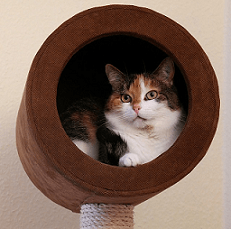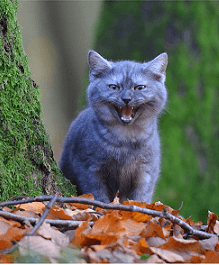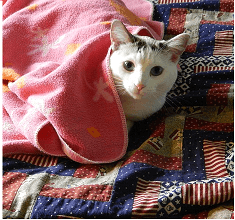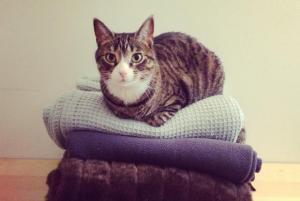For as long as people have kept cats, people have contested the value of an indoor or outdoor lifestyle. In researching the matter, it seems there is no definitive answer and it is left to the individual owner to judge for themselves. Depending on your circumstances and the cat in question, the decision might already be made for you. Some of us would never consider keeping a cat indoors and disconnected from the wild, but there are others who recognise the safety benefits of an 'indoor-only' cat whose farthest venture out is to pay a visit to the vet.
Establishing whether your cat is going to be an 'innie' or an 'outtie' is best done at the very start, when your new kitten is most adaptable. Weighing up the pros and cons of both lifestyles can be confusing and will often leave us with more questions than we started with!
Traditionally, all cats were free to indulge their natural instincts to hunt, mark their territory and socialise. That was until the advent of cat litter, when people first began considering keeping a cat indoors, becoming increasingly preoccupied with the whereabouts of their cat and the threats they were facing in the outside world.
 As a nation of animal lovers it is no surprise that we grew concerned about our out-of-house felines, and were no longer so willing to leave them to their own devices, preferring to have them inside at night and at meal-times.
As a nation of animal lovers it is no surprise that we grew concerned about our out-of-house felines, and were no longer so willing to leave them to their own devices, preferring to have them inside at night and at meal-times.
Out of this concern, 'indoor-only' cats have become common, and now 80% of all domestic cats are permanently housed inside – a surprising statistic I thought, and maybe you will agree. It is easy to call this arrangement inhumane when thinking about the primitive lifestyle enjoyed by the cat historically, although when faced with the often dire repercussions of keeping an outdoor cat, it is just as easy to see why more and more cat owners are opting to keep their pets inside. In a comfortable, shielded, and supervised environment.
For the sake of experiencing a free roam in the great outdoors, our cats are falling victim to many problems, from animal attacks to traffic collisions and infectious diseases. Whilst the threat to outdoor cats has always been there, the number one killer - cars - is a product of our developed world. Annually, it is thought that 1.5 million cats are killed by road traffic alone, a statistic that does not account for cats that have crawled into car engines for warmth and been killed when the car starts up. Yes – it happens, and if your cat is unlucky enough to die this way, chances are you will never hear about it. The minute your cat steps over your threshold and into the big bad world, you are relinquishing all control of its welfare. Life is unpredictable, especially for the inquisitive, outdoor cat.
Our 'outties' are also at greater risk of animal attacks, which can result in potentially fatal injuries, as well as infectious diseases such as feline leukemia, rabies and distemper. Parasitic infections are also more of a problem for outdoor cats that interact with other domestic cats and strays, helping to transmit their infestations and bring fleas and ticks into the home. In a similar way, outdoor cats will bring us ‘presents,’ which take the form of unwanted visitors, dead or alive, deposited on our doormats and carpets. Yuck!
 Poisoning is another outdoor hazard, with toxic plants and man-made chemicals appearing everywhere, from vermin baits and insecticides, to motor oil, ice-melt products and herbicides. Neighbours are also notoriously unpleasant towards outdoor cats, especially if they regularly deposit on a drive or a flowerbed, and incidences of feline entrapment and abuse are not uncommon. Theft is another widespread problem - for this reason, many owners opt to keep their pedigree, show or breeding cats indoors.
Poisoning is another outdoor hazard, with toxic plants and man-made chemicals appearing everywhere, from vermin baits and insecticides, to motor oil, ice-melt products and herbicides. Neighbours are also notoriously unpleasant towards outdoor cats, especially if they regularly deposit on a drive or a flowerbed, and incidences of feline entrapment and abuse are not uncommon. Theft is another widespread problem - for this reason, many owners opt to keep their pedigree, show or breeding cats indoors.
It seems the threats to outdoor cats are waiting around every bend, and while our cats are outside, we are powerless to protect them. Also, with vet bills on the increase, having a cat that is frequently maimed or injured can prove a big expense!
So with all these factors to deter us, why are so many people still keeping outdoor cats? Surely our want to meet their primitive needs is outweighed by our want to protect them?
The answer is simple: many people believe that keeping a cat permanently indoors is an act of cruelty, and is detrimental to its health and happiness. It may be that many of us just don’t have the time to care for a full-time house pet, and find a low-maintenance cat that takes care of itself very appealing. Indoor cats come with problems of their own and for many, these outweigh the drawbacks of owning an outdoor cat.
For a start, indoor cats require far more attention and care than the average outdoor cat. This can be taken to the extreme, and indoor cats can gain weight, being able to exercise very little, or develop behavioural problems associated with dependence. As well as gaining weight more easily, either because of over-feeding or general inactivity, indoor cats will reportedly sleep for 75% of the day, and can groom themselves for up to 4 hours, often resulting in the formation of hairballs.
These behavioural problems can lead to destructive boredom around the house, and far more domestic damage is caused by an indoor cat than an outdoor one. Such damage includes furniture scratching, urine marking and general indoor wear and tear. Unlike outdoor cats that only shed in spring, a house cat will shed continually, and regular grooming (as well as vacuuming!) will be necessary.
While nature provides a myriad of potential threats for a cat, so does the home, and appliances such as washing machines pose a grave hazard, as well as dishwashers, toilets, and exposed wires and sockets. Hiding, especially in dark, warm and concealed spaces, is a popular hobby of the house cat, and injuries can occur just as they would outside, with you being unable to locate your distressed feline friend.
 If your cat happens to escape and finds itself outdoors, having been raised inside from a kitten will make it more likely to panic and lose itself, being unable to cope in an unfamiliar setting of busy roads, loud noises and wild animals. If it hides, locating it again will be next to impossible. For this reason, always ensuring your cat is identifiable is crucial - either by an ID tube or pet tracker - whether it is an ‘innie’ or an ‘outtie,’ so that whatever happens you stand the best chance of being reunited with it again.
If your cat happens to escape and finds itself outdoors, having been raised inside from a kitten will make it more likely to panic and lose itself, being unable to cope in an unfamiliar setting of busy roads, loud noises and wild animals. If it hides, locating it again will be next to impossible. For this reason, always ensuring your cat is identifiable is crucial - either by an ID tube or pet tracker - whether it is an ‘innie’ or an ‘outtie,’ so that whatever happens you stand the best chance of being reunited with it again.
Ultimately, the decision to keep a cat indoors or out lies with you, its owner, and hopefully this article has reassured you that with such varying opinion on the matter, and with so many pros and cons for either, there is no concrete right or wrong. It all depends on what you hope your cat to gain from its life, and what you yourself are willing to invest.
Written by: Hannah
